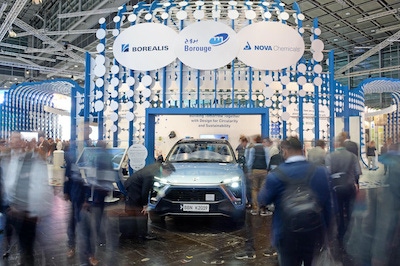PP makes its case in next-generation EVs
New design concepts and applications present a great opportunity to increase PP volume.
December 18, 2019

With vehicle mass at a premium in electric vehicles (EVs), polypropylene (PP) suppliers are developing an array of materials solutions to engineer weight out of autos and extend the range of EVs, and consequently reduce CO2 emissions. Applications include both exterior and interior parts, both structural and non-structural.
|
The NIO ES8 EV makes extensive use of PP for lightweighting. |
Take the plastic tailgate for example. According to Nicholas Kolesch, Head of Marketing, Automotive at Borealis, the metal structure and skin of a conventional tailgate for a c-segment vehicle has weight of approx. 16kg, whereas the same tailgate with a glass-fiber PP structure and PP TPO skin weighs in at 12 kg, a saving of 25%. “Furthermore, the design freedom of thermoplastics versus metal allows for functional integration of other tailgate components including spoilers, antennae, and rear lighting.”
Converting front fenders to PP can also save 2o–30% on weight as demonstrated in the ES8 SUV from China’s NIO. The next phase of car lightweighting will likely be conversion of doors and roofs.
EVs also bring new and unique applications to PP, such as the front trunk liner (frunk) in the Tesla Model 3. And despite the thermal requirement of EV drivetrain-related applications (see article on engineering plastics use in EVs), Borealis believes flame-retardant PP still has a major role to play. “We are looking into PP solutions for multiple aspects of battery systems that achieve V0 flame retardance, including structural applications to replace metal or engineering plastics,” he notes. “These include battery trays, cell holders, covers, and some of the elements of connectivity.”
PP is also playing a major role in the lightweighting of traditional internal combustion engine vehicles. Here Borealis has developed a series of short glass fiber-reinforced Fibremod PP compounds for use in front-end modules originally specified in polyamide (PA).
Pedal carrier and air intake manifold applications are also proving that PP can also take the pressure and heat. The Renault B4D engine, for example, uses a PP compound for the air intake manifold that weighs 15% less than a PA manifold and has a 20% lower system cost, all with material performance that is not dependant on humidity.
In interior components, meanwhile, the trend is towards lower talc loadings that deliver a lower density compound, while still achieving the right haptics along with scratch and mar resistance. “Some OEMs have even opted for neat PP, but these vehicles have reportedly achieved low ratings in JD Power surveys, with the components not holding up to wear and tear,” says Kolesch.
One example of a successful application of a low talc PP grade is in the instrument panel lower trims, glove box, and center console of the Skoda Scala. The 10% talc-filled grade from Borealis boasts low emissions, fogging and odor coupled with excellent scratch resistance and zero tackiness.
Another lightweighting tool in the Borealis toolkit is foamed PP. Daploy HMS resins are gaining traction in automotive, driven by lightweighting versus rigid components and recyclability versus alternative foam solutions like cross-linked polyethylene (XLPE). One application in this area is foamed automotive airducts. In this application, Daploy HMS can be processed using blow molding and sheet extrusion.
Daploy HMS resins target a density reduction up to 90% versus rigid PP. The combination of lightweight with increased thermal and acoustic insulation properties, while offering easy and widely available recyclability, make the material a resin of choice for driving the circular plastics economy forward.
About the Author(s)
You May Also Like




